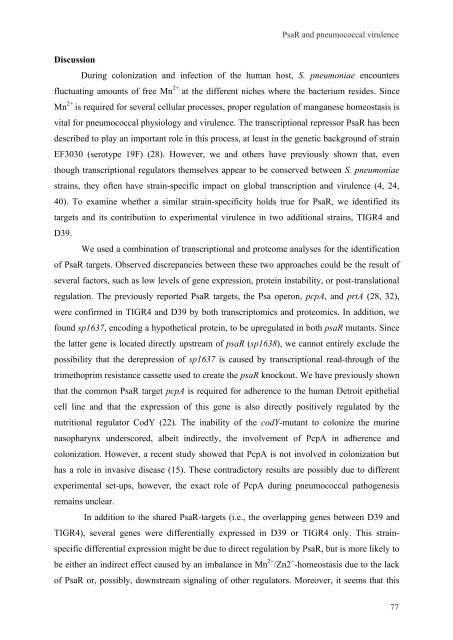Gene regulation in Streptococcus pneumoniae - RePub - Erasmus ...
Gene regulation in Streptococcus pneumoniae - RePub - Erasmus ...
Gene regulation in Streptococcus pneumoniae - RePub - Erasmus ...
You also want an ePaper? Increase the reach of your titles
YUMPU automatically turns print PDFs into web optimized ePapers that Google loves.
Discussion<br />
PsaR and pneumococcal virulence<br />
Dur<strong>in</strong>g colonization and <strong>in</strong>fection of the human host, S. <strong>pneumoniae</strong> encounters<br />
fluctuat<strong>in</strong>g amounts of free Mn 2+ at the different niches where the bacterium resides. S<strong>in</strong>ce<br />
Mn 2+ is required for several cellular processes, proper <strong>regulation</strong> of manganese homeostasis is<br />
vital for pneumococcal physiology and virulence. The transcriptional repressor PsaR has been<br />
described to play an important role <strong>in</strong> this process, at least <strong>in</strong> the genetic background of stra<strong>in</strong><br />
EF3030 (serotype 19F) (28). However, we and others have previously shown that, even<br />
though transcriptional regulators themselves appear to be conserved between S. <strong>pneumoniae</strong><br />
stra<strong>in</strong>s, they often have stra<strong>in</strong>-specific impact on global transcription and virulence (4, 24,<br />
40). To exam<strong>in</strong>e whether a similar stra<strong>in</strong>-specificity holds true for PsaR, we identified its<br />
targets and its contribution to experimental virulence <strong>in</strong> two additional stra<strong>in</strong>s, TIGR4 and<br />
D39.<br />
We used a comb<strong>in</strong>ation of transcriptional and proteome analyses for the identification<br />
of PsaR targets. Observed discrepancies between these two approaches could be the result of<br />
several factors, such as low levels of gene expression, prote<strong>in</strong> <strong>in</strong>stability, or post-translational<br />
<strong>regulation</strong>. The previously reported PsaR targets, the Psa operon, pcpA, and prtA (28, 32),<br />
were confirmed <strong>in</strong> TIGR4 and D39 by both transcriptomics and proteomics. In addition, we<br />
found sp1637, encod<strong>in</strong>g a hypothetical prote<strong>in</strong>, to be upregulated <strong>in</strong> both psaR mutants. S<strong>in</strong>ce<br />
the latter gene is located directly upstream of psaR (sp1638), we cannot entirely exclude the<br />
possibility that the derepression of sp1637 is caused by transcriptional read-through of the<br />
trimethoprim resistance cassette used to create the psaR knockout. We have previously shown<br />
that the common PsaR target pcpA is required for adherence to the human Detroit epithelial<br />
cell l<strong>in</strong>e and that the expression of this gene is also directly positively regulated by the<br />
nutritional regulator CodY (22). The <strong>in</strong>ability of the codY-mutant to colonize the mur<strong>in</strong>e<br />
nasopharynx underscored, albeit <strong>in</strong>directly, the <strong>in</strong>volvement of PcpA <strong>in</strong> adherence and<br />
colonization. However, a recent study showed that PcpA is not <strong>in</strong>volved <strong>in</strong> colonization but<br />
has a role <strong>in</strong> <strong>in</strong>vasive disease (15). These contradictory results are possibly due to different<br />
experimental set-ups, however, the exact role of PcpA dur<strong>in</strong>g pneumococcal pathogenesis<br />
rema<strong>in</strong>s unclear.<br />
In addition to the shared PsaR-targets (i.e., the overlapp<strong>in</strong>g genes between D39 and<br />
TIGR4), several genes were differentially expressed <strong>in</strong> D39 or TIGR4 only. This stra<strong>in</strong>specific<br />
differential expression might be due to direct <strong>regulation</strong> by PsaR, but is more likely to<br />
be either an <strong>in</strong>direct effect caused by an imbalance <strong>in</strong> Mn 2+ /Zn2 + -homeostasis due to the lack<br />
of PsaR or, possibly, downstream signal<strong>in</strong>g of other regulators. Moreover, it seems that this<br />
77<br />
77

















